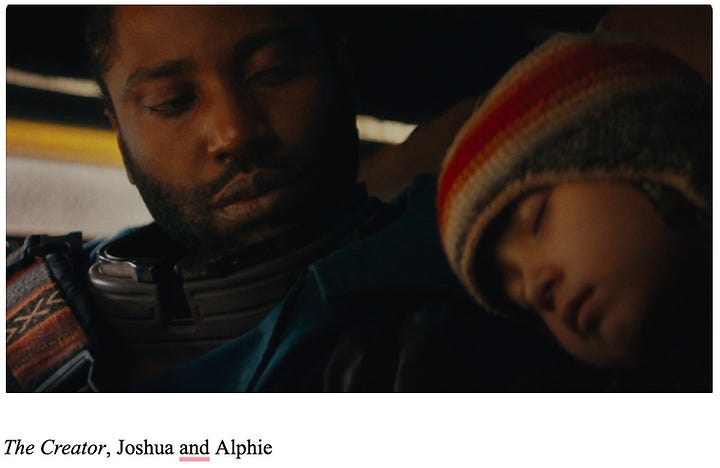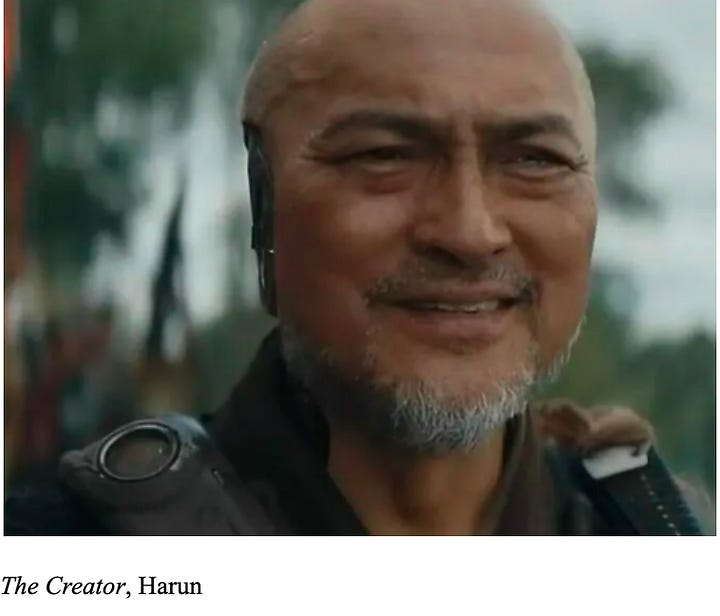Are synthetic sex identities grooming the public for synthetic humans? I am so pleased to welcome Alline Cormier with her report on "The Creator." I hope you enjoy it as much as I did.
By Alline Cormier
This article contains spoilers.
Presenting synthetic humans in the likeness of people, as the latest sci-fi about AI, The Creator does, and treating them like real people, grooms viewers for seeing people as objects (i.e. as less than human) and objects as people. This dehumanization paves the way for using women as parts—think surrogacy—for profit without incurring public outcries. It also paves the way for the biotech industry’s posthumanism, which bypasses women as the source of life. The Creator is simply the latest Hollywood feature film to normalize artificial females (previously I wrote about Lars and the Real Girl and Blade Runner 2049).
The Creator’s filmmakers aren’t the first men to promote synthetic humans. Consider American millionaire and transsexual transhumanist, Martine (né Martin) Rothblatt, a supporter of robot rights. Jennifer Bilek reports that he “has written extensively on the need to overhaul our system of labeling people as either male or female based only on their genitalia, … the future of creating humans, new reproductive technology...” Rothblatt also has a wife (Bina) and a robot replica of his wife (Bina48). In a 2016 interview, he said without a hint of irony, “AIs are people, too. The only difference is they’re people without skin.” A similar message is conveyed in The Creator.
Are AI robots (synthetic humans) entitled to the same rights as humans? The filmmakers behind The Creator think so. Their film conveys the message that humans and synthetic humans are the same. The Creator also reimagines the human species’ boundaries (i.e. technological reproduction). It isn’t likely to become the next sci-fi classic—it’s riddled with inconsistencies—it looks more like propaganda designed to normalize synthetic humans. Still, given that it has made over US$98 million at the box office, it merits analysis because movies play a role in shifting our attitudes.
The screenplay was directed by 48-year-old Gareth Edwards and co-written by Edwards and 53-year-old Chris Weitz. The duo had previously worked together on Disney’s Rogue One: A Star Wars Story (2016). Produced by New Regency, Bad Dreams, and eOne, The Creator had a production budget of US$80 million.
The score was entrusted to 12-time Oscar-nominated film score composer Hans Zimmer (two Oscar wins). The filmmakers wanted to ensure the score elicited the desired emotional responses in the audience.
The cinematography was entrusted to Oscar winner Greig Fraser (Dune, The Batman) and Oren Soffer. The latter’s website states he has shot hundreds of commercials for Nike, BMW, Doritos, etc. But unlike Zimmer and Fraser, Soffer hasn’t even received an Oscar nomination. This is his first big movie. One wonders: was he brought on board for his background in advertising?
Set in 2070 in ‘New Asia’, The Creator is the story of a U.S. Army sergeant named Joshua Taylor (John David Washington) who finds himself unable to destroy the new AI superweapon as ordered when he discovers it is a synthetic human child—an AI robot made by his deceased, pregnant wife Maya (Gemma Chan) from a copy of their unborn child’s embryo before she died, during the war opposing humans and AI robots.
Although humanity had initially embraced AI robots, in 2055 the AIs detonated a nuclear warhead over Los Angeles, leveling it (killing Joshua’s family). Consequently, the United States stopped developing AIs. Because New Asia continued, the two countries are at war, with the U.S. desirous of eradicating AIs. In 2065 AIs make their last stand in New Asia, where Joshua is sent undercover to get close to the daughter (Maya) of AI architect Nirmata. Joshua marries Maya. Later, a military attack on their home blows Joshua’s cover and results in Maya’s death before their baby’s birth.
Five years later, Colonel Howell (Allison Janney) and General Andrews (Ralph Ineson) enlist Joshua to find the lab where Nirmata is building a superweapon to destroy ‘NOMAD’, the U.S. Army’s space station. Joshua accepts the mission when told Maya survived NOMAD’s attack.
Up to this early point in the film, AIs are depicted as humankind’s enemy, but now things begin to change, leading the audience to consider AIs differently.
A U.S. soldier threatens to shoot a girl’s puppy if she refuses to disclose the entrance to Nirmata’s underground lab. Once inside, the soldiers shoot the lab workers—the first of numerous examples of AIs and their allies depicted as the victims of the ruthless army personnel (humans).
Joshua finds the superweapon: a synthetic child (Madeleine Yuna Voyles), watching TV with a stuffed toy. He disobeys Howell’s order to shoot it and names the artificial female Alphie. Joshua becomes increasingly attached to it, foils the military’s attempts to destroy it, and eventually loves it as his daughter.
Although Alphie is The Creator’s lead female, there are two other significant feminized synthetic humans: the likeness of Maya who appears at the end, and Kami, Joshua’s friend Drew’s girlfriend (Veronica Ngo).
The filmmakers use various devices to normalize synthetic humans and encourage viewers to consider them as people, including anthropomorphizing language, casting, portraying acceptance of AIs approvingly, lifelike portrayals of AIs and emotional manipulation, portrayals of AIs as morally superior to humans, etc. By humanizing their AIs, the filmmakers convey the message that humans and synthetic humans are the same and lead the audience to believe synthetic humans are entitled to the same rights as humans.
Anthropomorphizing language is used throughout to encourage us to view the AIs as people. For example, Joshua and others refer to Alphie using female pronouns.
The casting is similarly effective. For example, Alphie is played by an adorable little girl who says things like, “You my friend?” to Joshua. It’s the Shirley Temple of Androids—nothing like C-3PO and The Terminator. Seeing Alphie as just a robot is an uphill battle. Ken Watanabe plays Harun, the other lead AI. Both are likable synthetic humans.
Portraying acceptance of AIs approvingly teaches viewers to accept AIs. Alphie, as just one example, is treated like a child, including by the hero. Joshua increasingly behaves like a parent around it, carrying it in his arms, hugging it, etc. Every time it is treated like a girl, the lie that AIs and humans are the same is reinforced. This belief is even plainly stated a few times (e.g. “My father told me that underneath it all, we’re all the same”).
Referring to humans and AIs, a character says, “We’re all connected,” and viewers are led to agree. A news report shows human protesters condemning NOMAD attacks on AIs. The movie is about as subtle as a sledgehammer.
Lifelike portrayals of AIs and emotional manipulation gaslight us into going along and avoiding thinking critically about the messages conveyed. The filmmakers humanized the AIs nearly 100%. They appear to possess a consciousness. Alphie laughs with children, cries often and says it wants “For the robots to be free.” Alphie and Joshua scream when they are separated by the military. When Andrews entrusts Joshua with terminating Alphie (one of the aforementioned inconsistencies), Alphie asks through tears, “Am I going to heaven?” In the end, Joshua sacrifices himself to save Alphie.
These lifelike portrayals and emotional manipulation lead us to be affected when AI robots appear sad or are destroyed. And yet, there’s no reason for us to not remain impassive by what befalls robots. When we are, it’s because we’ve been groomed.
Portraying the AIs as morally superior to their enemies, namely U.S. Army personnel, further encourages us to consider synthetic humans entitled to human rights. The AIs are more empathetic than some of the lead human characters and appear just as capable of love as humans. Maya says to Joshua of the AIs, “They protected me, loved me, took better care of me than humans would’ve.” Harun says the bombing of L.A. was due to human error—not the AIs’ fault. Humans are depicted as callous, particularly Howell and her soldiers.
At the end, Alphie is safe and NOMAD is destroyed, falling from the sky to the cheering of AIs (read: the nice AIs triumph, and the nasty humans are punished as they deserve for failing to embrace AIs). The moral of the story: be progressive and play nice with AIs or you’ll find yourself on the losing end of a war.
No film analysis is complete without consideration of the female audience. The Creator doesn’t serve it well. There are just three or four brief exchanges between female characters. A woman in a position of power and authority (Howell) is portrayed negatively and killed off, as is the only other significant adult female human character, Maya (secondary character Kami is offed too). The only significant female character who isn’t is the AI (Alphie). Also, according to the all-male filmmaking team, the future includes females ‘exotic’ dancing.
My grandparents would have scoffed at the idea that robots are entitled to the same rights as humans—as, until recently, most people would. Unfortunately, their common-sense generation has all but disappeared. Younger generations are growing up in a mad age where the nonsensical is routinely accepted as possible (e.g. men are women if they say so).
The Creator’s filmmakers went to some lengths to advance the idea that synthetic humans are the way of the future—as Hollywood filmmakers are increasingly doing. It’s time moviegoers started asking themselves: why?
The Creator is rated PG-13. It has a running time of 133 minutes and was released on September 29.
Alline Cormier is a Canadian film analyst. This year her articles on women in film/TV have been published in The 11th Hour, Women Making Films (India), Feminist Current, 4W, and Gender Dissent. She is currently seeking a publisher for her film guide for women. Her website is found at sexualizationofwomen.com, and she tweets @ACPicks2. PayPal: PayPal.Me/AllineCormier
Author and Journalist, Jennifer Bilek, has been researching the money and power behind the gender industry for over a decade. Her work can be found in myriad publications, on her blog, on Twitter, Gettr, LinkedIn, Spinster.xyz, at this Substack, and in her new book: Transsexual Transgender Transhuman/Dispatches from the 11th Hour.
Your support for my work has been crucial and so appreciated. If you would like to continue supporting my research and analysis you can do so with a one off donation, by purchasing my book, or with a subscription to my substack. Thank you for your engagement.








Superb essay. Just reading about that movie gives me the creeps.
Interesting. I will not be watching this movie. There's an error in the review: Hans Zimmer obviously hasn't won the Academy Award 55 times. He has won it twice.